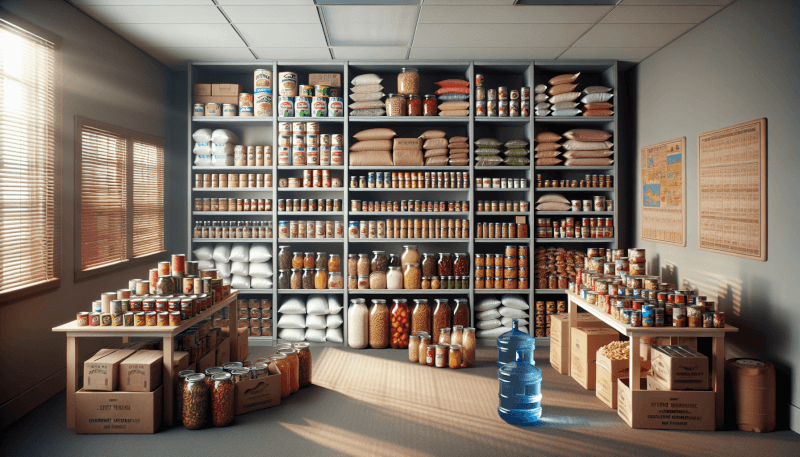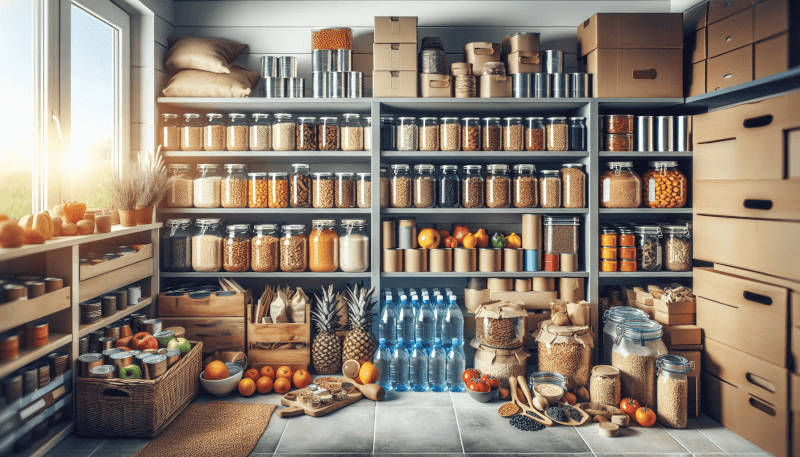Are you looking to build up your own food supply for long-term storage? Look no further! This comprehensive guide is designed specifically for beginners like you, providing step-by-step instructions on how to effectively stockpile food for extended periods. From choosing the right storage containers to preserving different types of food, this article has got you covered. Don’t miss out on this essential information that will help you prepare for any unforeseen circumstances and ensure you have ample food supplies for the future.

Choosing the Right Foods for Stockpiling
When it comes to stockpiling food for long-term storage, there are a few key factors to consider. First and foremost, you need to think about the shelf life of the foods you choose. Opting for items with long shelf lives will ensure that your stockpile remains viable for an extended period of time.
In addition to shelf life, it’s essential to focus on non-perishable items. These are food items that can be safely stored without refrigeration and won’t spoil or go bad easily. Canned goods, dried fruits, and nuts are excellent examples of non-perishable items that should be included in your stockpile.
Another important consideration is to include a variety of food groups in your stockpile. This will ensure that you have a well-rounded and balanced diet even in an emergency situation. Aim to include items from all food groups, such as grains, protein sources, fruits, and vegetables.
Lastly, don’t forget to take into account any dietary restrictions or preferences you or your family may have. If you have specific allergies or dietary requirements, it’s crucial to stockpile foods that cater to these needs. Consider gluten-free options, dairy-free alternatives, or vegan-friendly products to ensure everyone’s needs are met.
Calculating Adequate Food Quantities
Determining the right amount of food to stockpile can be a challenging task. However, by considering a few key factors, you can ensure that you have enough food to sustain yourself and your family during an emergency.
Start by determining the number of people you need to feed. Take into account all family members, including children and elderly individuals. This will give you a rough idea of the quantity of food you’ll need to stockpile.
Next, assess the duration of storage you are preparing for. Are you planning for a short-term emergency or a longer-term crisis? This will help you gauge how much food you should have on hand. It’s generally recommended to have at least a two-week supply, but if you are preparing for a more prolonged event, aim for a three-month supply if possible.
When calculating food quantities, it’s also important to consider caloric intake. Ensure that you have enough food to meet the daily caloric needs of each individual. This will vary depending on age, gender, and activity level, so do some research to determine the average caloric requirements for each member of your family.
Lastly, factor in personal preferences. While it’s important to prioritize nutrition and sustenance, having familiar and enjoyable foods during a crisis can provide comfort and a sense of normalcy. Try to include foods that your family enjoys and that can boost morale during challenging times.
Storing Food in Proper Containers
Properly storing your stockpiled food is essential for maintaining its freshness and longevity. By following a few key storage practices, you can ensure that your food stays safe and nutritious for an extended period of time.
Using airtight containers is a must when it comes to food storage. These containers create a barrier against moisture, pests, and oxygen, helping to preserve the quality of your food. Look for containers with secure lids that create a tight seal to keep your food fresh.
When choosing containers, opt for food-grade plastic or glass. These materials are non-reactive and won’t leach any harmful chemicals into your food. They are also durable and can withstand temperature fluctuations without compromising the integrity of the container.
Don’t forget to label your containers with the contents and dates. This will help you keep track of what you have and when it was stored. By rotating your stockpile and using older items first, you can ensure that nothing goes to waste.
For extended shelf life, consider utilizing vacuum-sealing techniques. Vacuum-sealing removes oxygen from the container, effectively preventing the growth of bacteria and mold. This method is particularly useful for storing dried goods, grains, and even meats.
Creating a Suitable Storage Environment
Aside from using proper containers, creating the right storage environment is crucial for preserving the quality and safety of your stockpiled food. Here are a few key considerations for creating an optimal storage space:
First and foremost, store your food in a cool, dry place. High temperatures can accelerate the degradation of food and lead to spoilage, while humidity can create a breeding ground for mold and bacteria. Aim for a storage area that maintains a temperature below 70°F (21°C) and a relative humidity below 50%.
Additionally, it’s important to avoid exposure to sunlight. UV rays can degrade the nutritional value of foods and also affect flavors and textures. Store your stockpile in a dark area, such as a pantry or basement, to minimize exposure to light.
Pests can pose a significant threat to your stockpiled food, so take precautions to keep them away. Seal any gaps or cracks in your storage area to prevent entry points for pests. Consider using traps or natural repellents to deter insects and rodents. Regularly inspect your stockpile for signs of pests and take immediate action if any infestation is detected.
Finally, ensure proper ventilation in your storage area. Good airflow helps to regulate temperature and prevent the buildup of moisture. Avoid overcrowding your storage space and leave some room for air to circulate around the containers.

Stockpiling Staples and Basic Ingredients
To create a well-rounded and versatile stockpile, it’s essential to include staple foods and basic ingredients that can be used to prepare various meals. Here are some key items to consider:
Rice, pasta, and grains are excellent sources of carbohydrates and can serve as a base for many meals. Opt for long-grain rice, whole wheat pasta, and a variety of grains such as quinoa, oats, and barley.
Canned goods and preserves are essential for their long shelf life and convenience. Stock up on canned vegetables, fruits, soups, and sauces. Don’t forget to include canned proteins such as tuna, chicken, and beans for a good source of protein.
Dried beans and legumes are an excellent source of plant-based protein and fiber. They can be stored for a long time and provide a nutritious addition to your stockpile. Consider options such as lentils, chickpeas, black beans, and kidney beans.
Flour, sugar, and salt are versatile ingredients that can be used in a variety of recipes. Stockpile all-purpose flour, baking flour, granulated sugar, and salt to ensure you have the basics for baking and cooking.
Including Long-lasting Protein Sources
Protein is an essential nutrient that provides energy and aids in repairing tissues. When stockpiling food, it’s important to include long-lasting protein sources to ensure that you maintain a balanced diet. Here are some options to consider:
Canned meat and fish, such as chicken, tuna, and salmon, are excellent sources of protein and can be stored for long periods of time. They can be used in various dishes or enjoyed on their own.
Peanut butter and other nut butters are nutrient-dense and provide a good amount of protein. They also have a long shelf life and can be enjoyed as spreads, used in baking, or added to smoothies.
Dried fruits and nuts are not only a great source of protein but also provide essential vitamins and minerals. Opt for varieties such as almonds, walnuts, and cashews, as well as dried fruits including raisins, apricots, and cranberries.
Powdered milk and protein powders are useful for maintaining a steady intake of dairy and protein. These products can be stored for long periods and can be easily incorporated into various recipes or consumed on their own.

Preserving Fruits and Vegetables
Fruits and vegetables are important sources of vitamins, minerals, and fiber. While fresh produce may not be viable for long-term storage, there are several ways to preserve their nutritional value. Here are some methods to consider:
Dehydrating fruits and vegetables is a great way to extend their shelf life without any additives. By removing the water content, dehydration helps to inhibit the growth of bacteria and mold. Invest in a food dehydrator or use your oven at a low temperature to dehydrate your favorite fruits and vegetables.
Canning fruits and vegetables involves packing them in jars or cans and processing them through heat to kill bacteria and create a seal. Canned fruits and vegetables can last for several years and retain much of their nutritional value. Follow proper canning procedures to ensure safety and to avoid spoilage.
Freezing fruits and vegetables is a simple and effective way to preserve their freshness. This method requires minimal preparation and can maintain the quality and texture of the produce. Invest in freezer-safe bags or containers to store your frozen fruits and vegetables, and always label them with the contents and date.
Making homemade jams and pickles is a delightful way to preserve fruits and vegetables while adding variety to your stockpile. Jams can be made from a variety of fruits, while pickles can be made from cucumbers, carrots, or other vegetables. Experiment with different recipes and enjoy the sweet and tangy flavors.
Additional Food Storage Considerations
In addition to the basics of stockpiling and storing food, there are a few additional considerations that can further enhance your preparedness. Take these factors into account to ensure a well-rounded and comprehensive approach to food storage:
Stockpile water for drinking and cooking. Ensure you have enough clean water to sustain yourself and your family in case of disruptions to the water supply. Aim for at least one gallon of water per person per day for a two-week supply.
Include necessary cooking and eating utensils in your stockpile. Ensure you have a reliable stove or alternative cooking methods, as well as pots, pans, plates, and utensils. Don’t forget can openers, kitchen knives, and other tools that may be necessary for food preparation.
Rotate your food supply regularly to maintain freshness and ensure that nothing goes to waste. Use older items first and replace them with fresh ones to maintain a constant supply of stockpiled food.
While focusing on your emergency food supply, it’s also important to maintain a well-stocked pantry for everyday use. By keeping a good stock of non-perishable items, you can reduce the frequency of trips to the grocery store and be prepared for unexpected situations.

Keeping Track of Expiration Dates
To ensure the safety and quality of your stockpiled food, it’s important to keep track of expiration dates. Here are some tips for managing and monitoring the dates of your stored food:
Develop a system for tracking dates that works for you. This could be as simple as creating a spreadsheet or using adhesive labels on your containers. Find a method that is easy to maintain and helps you identify which items need to be used or replaced.
Consume items before they expire whenever possible. Pay attention to approaching expiration dates and prioritize using these items in your meals. This will help prevent food waste and ensure that you are rotating through your stockpile effectively.
If you have items that are approaching expiration and cannot be consumed in time, consider donating them if possible. Local food banks or charitable organizations may be able to accept soon-to-expire items and distribute them to those in need.
Replace expired items with fresh ones to ensure that your stockpile remains viable and nutritious. Regularly check the dates on your stored food and make a point to include these items in your meals or discard them and replace them as needed.
Emergency Food Alternatives
While stockpiling food for long-term storage is crucial, it’s also important to have some readily available emergency food alternatives that require minimal or no preparation. These options are ideal for situations where cooking may not be possible. Here are a few examples:
Ready-to-eat meals and MREs (Meals Ready-to-Eat) are pre-packaged meals that are designed to provide a balanced and nutritious option in emergency situations. They usually have a long shelf life and require no cooking.
Energy bars and protein shakes are compact and convenient sources of nutrition. They are typically designed to provide a quick energy boost and can be easily stored in your emergency kit or vehicle.
Canned soups and stews can serve as a warm and comforting option during emergencies. These canned meals can be heated directly on a stove or with a portable heating source for a hot meal without much effort.
Instant noodles and dry soup mixes are simple and quick options that require only boiling water to prepare. They are lightweight, easy to store, and can provide a warm and satisfying meal when needed.
By considering these emergency food alternatives, you can ensure that you have options for various scenarios and be prepared for any unexpected event.
In conclusion, stockpiling food for long-term storage requires careful consideration of factors such as shelf life, non-perishability, food groups, and dietary preferences. Calculating adequate food quantities involves determining the number of people to feed, assessing the duration of storage, considering caloric intake, and accounting for personal preferences. Storing food in proper containers involves using airtight containers, selecting appropriate materials, labeling containers, and utilizing vacuum-sealing. Creating a suitable storage environment entails storing food in cool, dry places, avoiding sunlight exposure, keeping away from pests, and ensuring proper ventilation.
When it comes to the food itself, stockpiling staples and basic ingredients such as rice, pasta, canned goods, dried beans, flour, sugar, and salt is essential. Including long-lasting protein sources like canned meat and fish, peanut butter, dried fruits and nuts, and powdered milk and protein powders is crucial for a balanced diet. Additionally, preserving fruits and vegetables through methods such as dehydration, canning, freezing, and making homemade jams and pickles allows for variety and extended shelf life.
Other food storage considerations include stockpiling water, including necessary cooking and eating utensils, regularly rotating the food supply, and maintaining a well-stocked everyday pantry. Keeping track of expiration dates involves developing a system for tracking dates, consuming items before they expire, donating if possible, and replacing expired items with fresh ones. Lastly, having emergency food alternatives like ready-to-eat meals, energy bars, canned soups, and instant noodles allows for quick and convenient nutrition in unforeseen circumstances.
By following these guidelines and being prepared, you can ensure that you and your loved ones will have an adequate and diverse food supply during emergencies or other challenging times. Remember to review and update your stockpile regularly to maintain freshness and ensure readiness for any situation that may arise.



